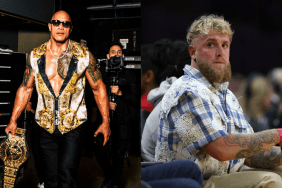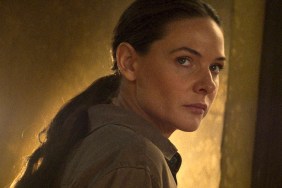The Gracefield Incident: Director and star Mathieu Ratthe’s discusses his new first person horror film
Writer and director Mathieu Ratthe’s upcoming found-footage shocker The Gracefield Incident tells the tale of Matthew Donovan (played by Ratthe himself), a video game editor who embeds an iPhone camera into his prosthetic eye to secretly record and document a weekend with friends in a luxurious mountain top cabin. The weekend takes a terrifying turn when a meteorite crashes the party, forcing everyone to face the darkest, screaming extraterrestrial nightmare imaginable.
Initially sold under the guise of being based on legitimate reports, The Gracefield Incident is a disorienting perversion of the “found footage” genre that is truly a labor of love from its triple threat creator, as we found out today in this exclusive new interview with Ratthe. Have a look!
ComingSoon.net: Now, I read that this movie is based on legitimate facts. How did you become initially involved in the interest in this case?
Mathieu Ratthe: Actually, no, it’s pure fiction. It’s pure out of my imagination, for sure. I mean, I got the idea a couple years ago with a couple friends – we saw a meteorite coming down, and we tried to find it for quite a while, actually. And we never found it, you know, but it’s always stuck in my mind, what would have been if – what was it? That question always was there? So, that’s what I based my script on. And then the conceptual idea of the technique that I used with the camera inside the prosthetic eye is that, when I wrote the script, it was not included in the script. It wasn’t in the first draft. And then when we came to after the first draft, we did the… with my line producer, with the budget… and then we did the schedule. And then we realized that I had 13 days to shoot this film with the budget that I had. So I knew that it was not going to be any camera set-up and different angles and this and that… a crane, and… so… we just decided, you know what? Let’s just put a camera on my shoulder at the same time as I’m acting. This is where the camera inside the prosthetic eye… I wanted to find a technology that was doable, that could be doable today, and that’s where I got the idea. But yeah, it’s completely all fiction.
CS: Well, I do love the gimmick about the camera in the eye, and I can legitimately say I’ve never seen that in a film, I don’t think, especially a found footage film.
Ratthe: Uh huh. I don’t like the term “found footage” because I think people are a little bit tired of it, which is – look, I’m a little bit the same way, as well. As you know, found footage was used in ’97 for a marketing tool when The Blair Witch Project came out, and it was genius, what these guys did! And then they just kept the term of “found footage.” You know, I always go back to Cloverfield, when they were making Cloverfield, they used that found footage technique, but still it’s just a camera technique, where it just looks real, but we know there’s no monster in New York. So, it’s a little bit, in my case, a little bit the same. Once you watch the film, you know that didn’t happen for real, and I’m not trying to make you believe this, you know? You’re really watching a movie that’s using a technique which was cheap for us. You know, that’s what we were able to do. And in independent filmmaking, you just try to do everything you can to make your movie done, and that’s what we did, and using that technique was useful for us, for that film.
CS: You said you had from the outset 13 days to shoot it. Now, did you actually stick to 13 days, or did you end up going over?
Ratthe: No, I mean, we did 13 days. After 13 days I had an hour and 48 minutes. So, the movie was there, but then, when I got in the editing — I was editing, as well — and, you know, I just make movies for the audience, for the target audience, and there was things I was not happy with, and things to change, so we shot a couple days just to make it happen, because we wanted to make it right. But it was a smaller unit when we shot the reshoot. I couldn’t have the big crew and all my people there. But, yeah, 13 days, we got it done, you know? We had a full feature after 13 days, which was insanely nuts, and this crazy shoot, but it was fun!

CS: How much was changed in the edit, based on the script?
Ratthe: I would say 25%. Why? Because I wrote the script pretty fast, and it was a window where I was able to shoot, I had the money to shoot, so… I mean, I wrote the film in about… the breakdown in two weeks, you know, and four months later I was shooting. So, it was a month and a half the script. So, I didn’t — as you know, the process — usually you have twenty drafts. My next film, I’m already at 27 drafts. You know, for years, because you do something, that people reading it, and then you go change things. But because I went in with my earlier draft, I knew I was going to change a couple things when I got in the editing bay, and that’s exactly what happened. I mean, look, I had the movie. It was done. But I didn’t want to go a while with that trim, I wanted to make it right, and we started doing the right process. If it was, you know, a hundred million dollar picture, we’d start test screening and looking at if it works, and if it didn’t work, and showing to a lot of people, and seeing their reaction and, oh, they’re laughing there, and they’re not scared there, you know, just to make it right, and I think that’s the normal process. But then, as the story got bigger, I had times where at the beginning I didn’t have an example of why it changed so much — but a change, just an example — I didn’t have the budget at the beginning to show too much of the monster. I showed bits of the monster, and you’ll see gradually I just get in, and I tried to get the monster more and more into the film, until the reveal at the end. But I didn’t have the budget, so, I created suspense through consequences and not actually seeing the monster. But when we got in the editing bay and we had the full film, then we realized, after the first test screening, the audience was pissed off, because they were like, “We wanna see a little bit of it.” But I just didn’t have the money, so I had to go back in and talk to my VFX guy and make deals then and there and solving problems, to make sure it worked for the audience. And we did. And that’s why it took five years from the first letter on a piece of paper to screen. So, it was a hell of a ride. A great ride. I’m so happy with the movie that we have. I’m glad we got it done.
CS: You said you didn’t have the luxury of test screening, but you did screen enough that people wanted more of the beast. You put the beast in there. But have you screened the final cut with an audience yet?
Ratthe: Yeah, yeah, yeah. We did. And the reaction, as a filmmaker, that’s exactly what you expect. You go in and you’re actually watching your film and you’re watching people react to what you put on screen, I mean, in my opinion, that’s the best pay off you can get. So, I would still be shooting and editing if it wasn’t right. It’s a little crazy, but it worked. And the last test screening was just the result I was expecting for the last five years. It was one of the best days of my life.
CS: To spend that much time on an independent film, where you have the luxury to tinker with it, I mean, even though you finished the film, the audience liked it, you walked away, it’s being released, how easy it for you to actually walk away from it now. Can you? Are you still wanting to tinker with it, or what?
Ratthe: No, no, no, no. I don’t have any heart when it comes to editing. Or when it comes to movies. Like, I always say, I don’t care who’s right, I want to know what’s right in the story. I work for one thing: the story itself. I want the story to work. For anything. It doesn’t matter if it’s a short film or a feature. And the next one will be the same. And I’m really listening. And at some point, no, I just let go. I let go, actually, two and a half years ago, when I knew the movie was there and everything was there, and there’s just the visual effects to complete, which took time, as well, but, no, I can let go pretty fast. When it’s done, you know it’s there, the actions are there, then you’re like, alright, I’m out. Let’s move to the next one.
CS: Obviously making a movie with what I assume was a modest budget and a very crunched time frame, you already mentioned all the things that you had to do that were, I guess, necessity being the mother of invention. But casting yourself – was that always by design or was that just something that you thought, “Well, no one can do it better than me and here I go?”
Ratthe: You know what? I didn’t cast myself at first. I never thought I was going to do it. I gotta be honest, I was writing this script for somebody else, but then, when the reality came in where we had 13 days to shoot this… I knew I was going to operate the camera, and at some point I knew I didn’t have time to switch actors reading the lines next to me and running next to me and all this, and I said, “Who knows better the lines than me?” I was like, you know what? I’ll put myself in. And at first I was just supposed to see myself in reflections. But then, when we did the first test screening, one of the top comments was, “We wanna see that guy more.” That’s why I had another camera in that once in a while I cut back to him, because they wanted to know who was their hero, who was the protagonist, not just the camera itself. So, I had to do this. So, at some point I realized, all right, I’m pulled in now. That’s why you’ll see when you’re watching the film, I look like a director. I’m not gonna lie. And I always tell that story – the hair girl came in and she was like, “How do you want your hair?” And I was like, “No, I’m gonna wear a hat.” And she was like, “You’re gonna wear a hat the full film?” And I’m like, “Yes!” Because I was sweating, with my camera on my shoulder, I’m running through the woods and I gotta switch and do my shot, you know? When I’m in front of the camera, there’s no time for make-up or anything!
CS: Well, that’s really fascinating, because of that very conceit. Even though the movie is a fiction, the line between fact and fiction is completely blurred. And in many respects the feature, I guess, is kind of your B-roll, is your behind-the-scenes documentary, as well.
Ratthe: That’s right. Yeah. Exactly. We could have a really long conversation about the full process at one point, but… yeah, it was a really challenging process for me and I think for the entire crew. And just a little story on the side, but, I shot it in 13 days, right, and I had an unbelievable crew and what we did, I mean, I had the cabin as the main set but the cabin was actually on the domain with 14 other luxury cabins, and I had my crew, my cast, everyone, sleeping on set for the time of the shoot. For two or three weeks. And then everyone at first was kind of doubting me, and were like, “Are you serious?” And I’m like, “Yeah.” And then we blocked the entire domain, but you know what? I was so much fun! It was like a big party, it was a like a big family party! We went on for three weeks. At the end of the shoot we were like, “Why isn’t this longer?” And it was the only way I was able to make this film. It was crucial to have that crew with me and behind me, and really be focused on one thing when we wake up in the morning and be like, “All right, let’s shoot this film.”
The Gracefield Incident hits theaters, On Demand and Digital HD on July 21st from Momentum Pictures.









